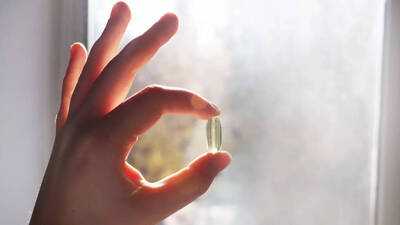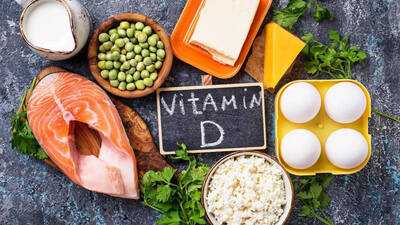Breast cancer is the most common cancer among women, with well-known risk factors like age, genetics and lifestyle. But some experts wonder if another factor could play a role: vitamin D. This “sunshine vitamin” helps build strong bones and supports immune function, yet many women have low levels. Could a hidden vitamin D deficiency quietly raise breast cancer risk? Researchers are studying this question. Early lab and population studies suggest vitamin D can slow cancer cell growth and women with very low D levels seem to have higher breast cancer rates.
What is vitamin D and why does it matter?

Vitamin D is produced in our skin under sunlight and is also found in few foods. In the diet, oily fish (salmon, tuna), egg yolks and fortified products (milk, cereals) provide vitamin D. For most adults the US Institute of Medicine recommends about 600 IU (15 μg) daily. . A blood level of about 20 ng/mL (50 nmol/L) is considered adequate; below 12 ng/mL (30 nmol/L) is generally seen as deficient. In fact, an NIH survey found roughly one-quarter of Americans have levels below this threshold.
Many common foods are fortified with vitamin D to help meet needs. For example, milk cartons (like the one shown) and breakfast cereals often contain added vitamin D. This is important because modern lifestyles can limit sun exposure.
Vitamin D and breast cancer

Is vitamin D deficiency a hidden breast cancer risk factor? The evidence is mixed. Laboratory experiments show active vitamin D hormones can slow breast tumor growth and even trigger cancer cell death.
In one German case-control study, postmenopausal women with low vitamin D (<12 ng/mL) had roughly three times the breast cancer risk of those with higher levels (≥30 ng/mL).
On the other hand, large observational studies and trials have been less clear. The US National Cancer Institute notes that most observational research did not find a link between blood vitamin D levels and breast cancer incidence.
In short, researchers caution that low vitamin D might be a marker of other health factors (like low sun exposure or obesity) rather than a direct cause. Still, given how vitamin D influences cell growth and immune function, many scientists agree it’s worth studying further.
Prevention and what you can do

Get some sun, safely. Try to spend 10–20 minutes a few times a week outside with arms and legs exposed, when the sun is strong. This natural boost can raise vitamin D, but avoid sunburn by moving into shade or using sunscreen after a short time.
Eat vitamin D-rich foods. Include oily fish (salmon, mackerel), egg yolks and fortified foods (milk, orange juice, cereals) in your diet. These natural sources (and added D) help keep levels up
Ask about testing and supplements. If you have risk factors (dark skin, obesity, older age, or limited sun), talk to your doctor about a 25(OH)D blood test. If you’re deficient, a supplement (often 600–2000 IU daily, as advised by a physician) can bring levels into the healthy range.
Follow general health guidelines. Maintain a healthy weight, stay active, limit alcohol, and get regular screenings (mammograms, clinical exams). These are well-established ways to lower breast cancer risk.
What is vitamin D and why does it matter?

Vitamin D is produced in our skin under sunlight and is also found in few foods. In the diet, oily fish (salmon, tuna), egg yolks and fortified products (milk, cereals) provide vitamin D. For most adults the US Institute of Medicine recommends about 600 IU (15 μg) daily. . A blood level of about 20 ng/mL (50 nmol/L) is considered adequate; below 12 ng/mL (30 nmol/L) is generally seen as deficient. In fact, an NIH survey found roughly one-quarter of Americans have levels below this threshold.
Many common foods are fortified with vitamin D to help meet needs. For example, milk cartons (like the one shown) and breakfast cereals often contain added vitamin D. This is important because modern lifestyles can limit sun exposure.
Vitamin D and breast cancer
Is vitamin D deficiency a hidden breast cancer risk factor? The evidence is mixed. Laboratory experiments show active vitamin D hormones can slow breast tumor growth and even trigger cancer cell death.
In one German case-control study, postmenopausal women with low vitamin D (<12 ng/mL) had roughly three times the breast cancer risk of those with higher levels (≥30 ng/mL).
On the other hand, large observational studies and trials have been less clear. The US National Cancer Institute notes that most observational research did not find a link between blood vitamin D levels and breast cancer incidence.
In short, researchers caution that low vitamin D might be a marker of other health factors (like low sun exposure or obesity) rather than a direct cause. Still, given how vitamin D influences cell growth and immune function, many scientists agree it’s worth studying further.
Prevention and what you can do
Get some sun, safely. Try to spend 10–20 minutes a few times a week outside with arms and legs exposed, when the sun is strong. This natural boost can raise vitamin D, but avoid sunburn by moving into shade or using sunscreen after a short time.
Eat vitamin D-rich foods. Include oily fish (salmon, mackerel), egg yolks and fortified foods (milk, orange juice, cereals) in your diet. These natural sources (and added D) help keep levels up
Ask about testing and supplements. If you have risk factors (dark skin, obesity, older age, or limited sun), talk to your doctor about a 25(OH)D blood test. If you’re deficient, a supplement (often 600–2000 IU daily, as advised by a physician) can bring levels into the healthy range.
Follow general health guidelines. Maintain a healthy weight, stay active, limit alcohol, and get regular screenings (mammograms, clinical exams). These are well-established ways to lower breast cancer risk.
You may also like

Russia planning own space station: Former Russian cosmonaut

Eliud Kipchoge sets sights on marathon grand slam

In talk with Donald Trump, PM Modi hails success of Gaza peace plan

India one of the most technologically inclusive societies in world: PM Modi

Echoes of two minds: Gill and Chase stand on opposite sides of form as India aim for clean sweep against West Indies






